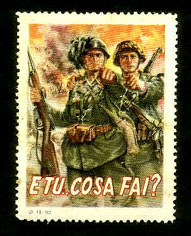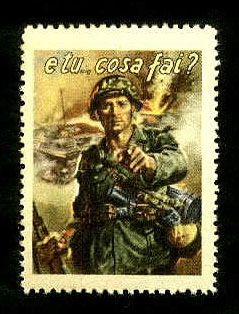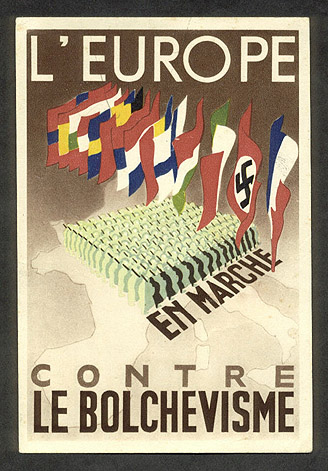Introduction
to Foreign Legion Stamps and Postal History
|
Introduction
This
narration provides a historical military and postal background
on Foreign Volunteer Legions that fought along Side the Germans.
The first recruitment of foreigners in the German Army was during
the annexation of Austria, what the Germans called the "Anschluss"
(reunion).
By early 1941, the German army drafted thousands of
"Volkdeutsches" (ethnic Germans) from the "Sudetenland" (a borderland
region that was located in the occupied Czech region known as
Bohemia-Moravia Protectorate), Memel, Lithuania, and from the
border districts of Eupen-Malmedy, Belgium and Alsace-Lorraine,
France. These foreigners were considered German citizens.
It was
not until the Russian invasion of 22 June 1941, that Germany obtained
full military support from its Axis partners, and the ethnic German
community living in those countries. During the opening campaigns
Finland, Romania, Hungary, Italy and Slovakia supplied more then
200,000 men, which were maintained up to 1942. Their numbers,
however great were no substitute for the soldiers the German army
had lost. As a result in the losses suffered during the opening
offensive drive of 1941, there were 359,000 fewer men. By summer
of 1942, another 470,000 men were lost.

The German Army Command,
new that in 1944, the Waffen-SS and army formations composed of
German and western Europeans were formations shattered in Russia.
In addition, the resistance warfare in Europe during 1942 and
1943, had been held in check by the use of Security Divisions
and units of the occupation forces. However, this was draining
the manpower required on the Eastern Front. As the Germans penetrated
deep into Russian territory more Soviet nationals were being taken
prisoner (because of all the different nationalities that used
to form the Soviet Union, the term Russian or Soviet is use interchangeable
and loosely).
The Germans needed manpower to handle the losses,
the partisan menace and the increasing numbers of Soviet POW's.
As a result of this, the German Army High Command became more
tolerant in receiving thousands of Soviet POWs that wanted to
serve the German Army, although, they were prohibited, because
they were being used as forced labors for German military plants.
These Russian POW troops were initially used as "Hilfwilligen"
(Auxiliaries), eventually, active recruitment was carried out
among the fiercely anti-communist races of the Baltic Nations,
Ukrainians, Caucasus, Cossack nations and other non-Russian peoples.
What motivated these men to take arms against the Soviets? The
motives of these volunteers were of a complex nature, and as diversified
as the various nationalities. Needless to say there were three
main aspects that influenced these foreign volunteers to join
the German Forces:
(1) To stop the expansion of communism, because
of the fear of communist invading their homeland
(2) They were
influenced by the idealistic political views of their parties,
such as the pro-Nazi governments in western occupied Europe.
(3)
The liberation of their homeland, as in the different nationalities
that exist in the Baltic states and the rest of what used to be
the Soviet Union.
All military units from these countries retained
their national uniforms, while Spain and Croatia and a substantial
number of volunteers from other nationalities adopted the German
Army uniform, but with a special insignia to identify their country
of origin. In addition, the Germans recruited Arabs and Indian
POW volunteers to serve for the German Army. These men did not
serve on the Eastern Front.
|
|
Foreigners
in the Wehrmacht
Meanwhile
during 1941, the non-Germanic Legionnaires were recruited by the
German Wehrmacht in France and the French speaking Walloons, from
Belgium (late in 1943, they were incorporated into the Waffen-SS).
In addition neutral countries such as Spain provided Germany with
full military manpower support. The recruitment of foreign volunteers
was a cooperative effort between the German military offices installed
in occupied countries and the pro-Nazi organizations of those
countries.
Because of the vast region in the Soviet Union and
the quantities of manpower needed, the Wehrmacht started recruiting
eastern foreigners right from the start. The majority of volunteers
came from the Baltics and the Ukraine. They were drafted into
labor and construction battalions. Later these battalions under
the watchful eyes of the SS, were converted into Police Units.
As the war progress more and more foreigners were conscripted
or joined German formations. The Luftwaffe (Airforce) and Kriegmarine
(Navy) also recruited foreigners.
All volunteers in the German
Armed Forces had to recite an oath of allegiance to Hitler, and
for the fight against bolshevism. When possible, German personnel
fluent or capable in speaking in the respective language were
attached to all foreign volunteer units for liaison and administrated
control.
The
enlistment of foreigners in the German Armed Forces were in some
way successful, because of the important role that propaganda played
in occupied and neutral Europe. Initially the Germans felt that
western foreign volunteer Legions had significant propaganda value
as symbols of a European Crusade against Bolshevism. Furthermore
western European volunteers were regarded as potential leaders of
their countries. The collaboration regimes under German military
administration issued a number of stamps, postcards and posters
encouraging enlistment of their citizens. These types of propaganda
arouse much public interest because stamps, postcards and posters
are colorful, imaginative, concise and provocative.
Legion Propaganda Stamps
Western
European Legions were partially supported by the sale of Legion
Postage Stamps. These stamps fell into two general classifications:
(1) Legion stamps printed with no postal value and only used for
propaganda and philatelic purposes (these were usually purchased
by the Legionnaires and family members);
(2) semi-postal stamps,
produced in the country that formed the particular Legion (these
stamps had postal power). The term semi-postal indicates a stamp
with two values on it. The first number is the actual cost of postage,
while the second constituted the surtax, used to support the Legionnaires.
The sale of charity labels was encouraged by the German postal administration
and recruiting stations. Family members or collectors often arranged
for complete sets of labels to be affixed to envelopes, which were
canceled to order at Waffen-SS recruiting offices. For example collectors
and stamp dealers from Flanders, prepared covers with a complete
set of charity labels addressed to designated SS-recruiting station
at FPN 07515AP. These covers with a SASE and payment of 200Francs,
were sent to the "VLAAMISCHE VOORZORGSCOMTIG" (Flemish Charity Committee),
Laken- weversstraat 1, Brussels. The SS censored covers were only
available for a limited time, usually for one month after the labels
were placed on sale.
It should be noted that some countries such
as Latvia and Ukraine made Legion labels to support the volunteers.
However, in the case of Latvia, the stamps were issued late in the
war to be considered by the German postal authorities.

Since most
of the Legions were combat forces, mail went through the regular
"Feldpost" (field post) offices of the Wehrmacht, Luftwaffe, Kriegsmarine
and Waffen-SS.
The first degree applying the usage of Feldpost for
foreigners in the German forces was 17 July 1941, at the direction
of the German Navy.
Depending on the postal agreements done with
the collaborating countries, postcards, letters and newspapers up
to 250gms were delivered free of charge to all military personnel.
Packages of 250gms to 1000gms were permitted against payment of
a 20Rpf fee. To address a letter to a military member, one had only
to write the individual's name and rank and his Feldpost unit number
on the envelope. All such letters had to be submitted for censorship.
Legion mail is categorized in the following groups:
A. Legion mail
sent from the homeland to the Front Lines.
B. Legion mail sent from
the Front Lines to the homeland.
C. Legion mail sent from soldier
to soldier.
D. Legion mail using propaganda labels (philatelic or
non-philatelic).
E. Legion mail process through civilian post office.
[Front
Page ] [Top] [Previous Page] [Next Page]
|
|


